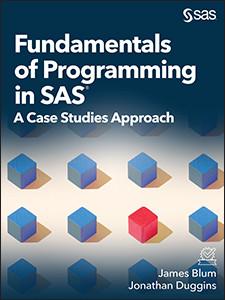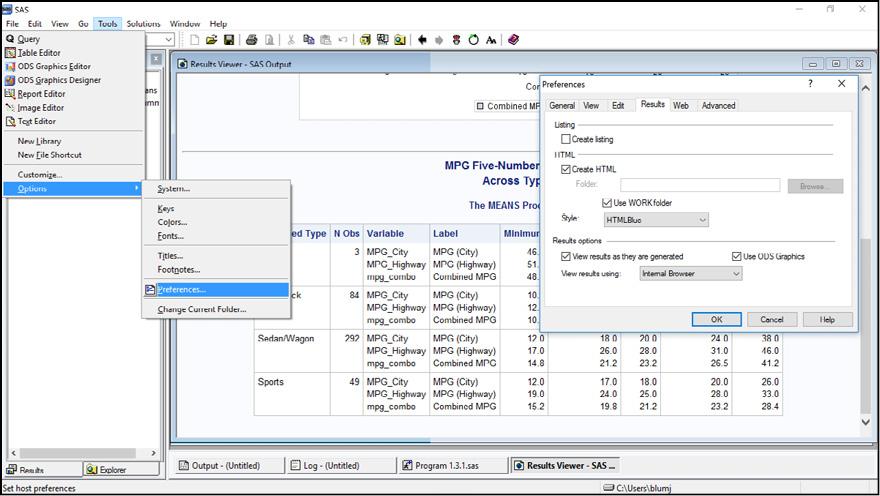Fundamentals of Programming in SAS A Case Studies Approach James Blum
Visit to download the full and correct content document: https://textbookfull.com/product/fundamentals-of-programming-in-sas-a-case-studiesapproach-james-blum/

More products digital (pdf, epub, mobi) instant download maybe you interests ...

SAS certification prep guide base programming for SAS 9 Fifth Edition. Edition Sas Sas Sas
https://textbookfull.com/product/sas-certification-prep-guidebase-programming-for-sas-9-fifth-edition-edition-sas-sas-sas/

SAS Certified Specialist Prep Guide Base Programming Using SAS 9 4 Sas
https://textbookfull.com/product/sas-certified-specialist-prepguide-base-programming-using-sas-9-4-sas/

SAS Certification Prep Guide Base Programming for SAS 9 4th Edition Sas Institute
https://textbookfull.com/product/sas-certification-prep-guidebase-programming-for-sas-9-4th-edition-sas-institute/

Perl 6 Fundamentals: A Primer with Examples, Projects, and Case Studies Moritz Lenz
https://textbookfull.com/product/perl-6-fundamentals-a-primerwith-examples-projects-and-case-studies-moritz-lenz/

EMG Lesion Localization and Characterization A Case Studies Approach 1st Edition Mark A. Ferrante
https://textbookfull.com/product/emg-lesion-localization-andcharacterization-a-case-studies-approach-1st-edition-mark-aferrante/

Lessons in Corporate Finance A Case Studies Approach to Financial Tools Financial Policies and Valuation Paul Asquith
https://textbookfull.com/product/lessons-in-corporate-finance-acase-studies-approach-to-financial-tools-financial-policies-andvaluation-paul-asquith/

Step by Step Programming with Base SAS 9 4 Second Edition Sas Institute
https://textbookfull.com/product/step-by-step-programming-withbase-sas-9-4-second-edition-sas-institute/

Understanding Religious Violence: Radicalism and Terrorism in Religion Explored via Six Case Studies
James Dingley
https://textbookfull.com/product/understanding-religiousviolence-radicalism-and-terrorism-in-religion-explored-via-sixcase-studies-james-dingley/

Case Studies in Immunology A Clinical Companion Raif Geha
https://textbookfull.com/product/case-studies-in-immunology-aclinical-companion-raif-geha/
Foreword
ToReaders
ThisbookisdesignedtohelpyoudevelopanunderstandingoftheSASprogramming languageandtohelpyoudevelopgoodprogrammingpractices.Itisintendedasa learningguideandaskillbuilder,notasareferencebook.Tothatend,itintroducessets oftopicswithineachchapterthatareconnectedthroughasinglecasestudy.Concepts areintroducedonanas-neededbasistocompleterequiredtasks,soyouareimmediately exposedtowritingcompleteprograms.Asfurtherconceptsareintroducedtheymightbe newtopics,ortheymightrevisitpreviouslyintroducedtopicsatamorecomplexlevel. ThisreflectshowmanyofthebestSASprogrammershavebuilttheirtalents by continuallyaddinglayersofknowledgeontoabasesetofskills.Thebookmimicsthis typeofexperiencebyincreasingthecomplexityofthecasestudy,requiringtheaddition ofnewerskills,ormorecomplexversionsofearlierskills,astheyareneeded.
Becauseofthiscirclingbacktocontentfrompreviouschapters,apedagogicalconcept knownasaspiralcurriculum,youwillnotlearneverythingthisbookcoversonatopicin anysinglechapter.Ofcourse,noonebookcouldservethepurposeofgivingacomplete treatmentofallconceptsincluded;therefore,youwilloftenbereferredtooutside resources,suchasSASDocumentation,forafulldescriptionofsyntaxorformore detailedcommentary.SASDocumentationisthestandardizednameusedinthistextfor thecollectionofhelpfilesandexamplesprovidedbySASThisdocumentationis availableviatheHelpmenuinSASoronline.Readingsuchreferencesisastrategy commonlyusedbythebestSASprogrammerstorefinetheirabilitiesandisanimportant habitforyoutodeveloptobuildyourskillsasaSASprogrammerandtoexpandonthose skillsinthefuture.
Duetotheintroductionofconceptsinspiralfashion,itisimportanttobeginwiththe setupmaterialinChapter1andthentoproceedthroughthebooksequentially.Foreasy reference,thenumberingonalloutputinChapters1through7directlycorrespondsto thenumberoftheprogramthatgeneratesit.However,notallprogramsgenerateoutput. Inallchapters,theprograms,output,tables,andfiguresarenumberedsequentiallywithin eachsection.Thesamecasestudyisusedtoprovidecontinuitythroughthenarrative whenbuildingonearlierconcepts.Othercasestudiesarealsoavailableforusetobuild continuityforadditionalprogrammingactivitiesandexercises.Thisincludesacasestudy locatedinChapter8forwhichthesectionsarealignedwiththelearningobjectivesof eachchapter.Additionalcasestudiesareavailableonlinebyvisitingtheauthorpagefor eitherauthor.
ToClassroomInstructors
Asstatedintheprevioussection,thisbookisdesignedtotapintosomeofthebest practicesineducationaltheoryasitspiralsbackontotopicsthroughoutyourcourse.Itis designedbyinstructorswithover25yearsofcombinedexperienceinteachingSASeither intheclassroomorinindustry.Themoretechnicaldetailsareisolatedintheirown sectionssothatyoucaneasilyincludeorexcludethemtofittheneedsofyourcourse. Multiplecasestudiesarealsoprovidedsothatthecasestudyassignmentscanbe customizedforyourstudents’interestsandtothecontentpresentedinyourcourse.The casestudyprovidedinChapter8ensuresstudentshaveimmediateaccesstoacasestudy forreferencewhilereadingthetext.Additionalcasestudiesaremadeavailablethrough theauthorpagesforeitherauthortoensureyougetthebenefitofupdatedmaterialsona regularbasis.Anyinstructionalmaterialswillalsobeavailableeitherviatheauthorpages (forpublicresources)orbycontactingSAStoverifyyourstatusasaninstructor(for instructor-onlymaterials).Theseresourceswillberegularlyupdated.
AbouttheIPUMSCPSData
TheIPUMSCPSdataincludestheIntegratedPublicUseMicrodataSeries(IPUMS)and CurrentPopulationSurvey(CPS)beginningin1962.Thesedatasetsprovideperson-and household-levelinformationaboutavarietyofdemographicvariables.Across-sectionof recentdata(2001,2005,2010,and2015)wasreleasedforthispublicationandis includedhereasthemaincasestudyinthenarrative Visithttps://cpsipumsorgtolearn moreabouttheIPUMSCPSortoextractnewerdatatocontinuehoningyourSAS programmingskills.
AboutThisBook
WhatDoesThisBookCover?
ThistextcoversawidesetoftopicsavailableintheBaseSASsoftwareincluding:
DATAstepprogrammingincluding:
Readingdatasetsfromnon-SASsources
CombiningandrestructuringSASdatasets
Functionsandconditionallogic
DOloopsandarrays
Basicanalysisprocedures:MEANS,FREQ,CORR,andUNIVARIATE
Reportingprocedures:CONTENTS,PRINT,andREPORT
RestructuringdatawithPROCTRANSPOSE
VisualizationwiththeSGPLOTandSGPANELprocedures
SASformatsandtheFORMATprocedure
OutputDeliverySystem
Whilethisbookcoversthefoundationsofthetopicslistedabove,additionaldetailsare oftenbeyondthescopeofthistext.Referencesareprovidedforthoseinterestedin furtherstudy.
IsThisBookforYou?
AreyoutryingtolearnSASforthefirsttime?Areyouhopingtoeventuallyearnyour BaseSAScertificationandbecomeaSASCertifiedProfessional?Areyoualready comfortablewithsomeSASprogrammingbutarelookingtohoneyourskills?Ifthe answertoanyofthosequestionsis“yes,”thenthisisthebookforyou!Thisbooktakesa novelapproachtolearningSASprogrammingbyhelpingyoudevelopanunderstanding ofthelanguageandestablishgoodprogrammingpractices.Byfollowingasinglecase studythroughoutthetextandcirclingbacktopreviousconcepts,thisbookaidsinthe learningofnewtopicsthroughexplicitconnectionstopreviousmaterial.Justasthebest SASprogrammersexpandtheircapabilitiesbycontinuallyaddingtotheiralready impressiveskillsets,asyoureadthistextyouwillgaintheskillsandconfidencetotake onlargerchallengeswiththepowerofSAS.
ThisbookdoesnotassumeanypriorknowledgeoftheSASprogramminglanguage. However,anunderstandingofhowfilepathsfunctioninyouroperatingsystemis necessarytofacilitatethestorageandretrievalofdatasets,rawdatafiles,andotherfiles suchasdocumentsandgraphics
WhatShouldYouKnowAbouttheExamples?
Thisbookincludestutorialsforyoutofollowtogainhands-onexperiencewithSAS.The majorityoftheexamplesarebasedonacasestudyusingrealdata.Someexamplesuse subsetsofthecasestudydataorintroducesmallerdatasetstohelpillustrateatopic. Chapters2through7containawrap-upactivitythatusesthecasestudytotietogether conceptsfromthecurrentchapter,andeverychapterreferencesanothercasestudy containedinChapter8forfurtherpractice.Youneedaccesstothesoftwarelistedinthe nextsectiontocompletetheexercises.
Foreasyreference,thenumberingonalloutputinChapters1through7directly correspondstothenumberoftheprogramthatgeneratedit.However,notallprograms generateoutput.Inallchapters,theprograms,output,tables,andfiguresarenumbered sequentiallywithineachsection.
SoftwareUsedtoDeveloptheBook’sContent
SAS9.4TS1M3andhigherwereusedtodeveloptheexamplesandexercises.Tofollow alongwiththeexamplessimultaneouslyortocompletetheexercises,youonlyneedthe BaseSASsoftwareexceptfortheportionsofChapters7and8thatuseSAS/ACCESSto connecttoMicrosoftExcelworkbooksandMicrosoftAccessdatabases.
ExampleCodeandData
Youcanaccesstheexamplecodeanddataforthisbookbylinkingtoitsauthorpageat https://support.sas.com/authors.
SASUniversityEdition

ThisbookiscompatiblewithSASUniversityEdition.IfyouareusingSAS UniversityEdition,thenbeginhere:https://support.sas.com/ue-data.
WhereAretheExerciseSolutions?
Readers:Exercisesolutionstoselectedexercisesarepostedontheauthorpageat https://support.sas.com/authors.
ClassroomInstructors:Toobtainthefullsolutions,contactsaspress@sascom
WeWanttoHearfromYou
DoyouhavequestionsaboutaSASPressbookthatyouarereading?Contactusat saspress@sas.com.
SASPressbooksarewrittenbySASUsersforSASUsers.Pleasevisitsas.com/booksto signuptorequestinformationonhowtobecomeaSASPressauthor.
Wewelcomeyourparticipationinthedevelopmentofnewbooksandyourfeedbackon SASPressbooksthatyouareusing.Pleasevisitsas.com/bookstosignuptoreviewa book
Learnaboutnewbooksandexclusivediscounts.Signupforournewbooksmailinglist todayathttps://support.sas.com/en/books/subscribe-books.html.
Learnmoreabouttheseauthorsbyvisitingtheirauthorpages,whereyoucandownload freebookexcerpts,accessexamplecodeanddata,readthelatestreviews,getupdates, andmore:
http://support.sas.com/blum http://support.sas.com/duggins
AboutTheseAuthors

JamesBlumisaProfessorofStatisticsattheUniversityofNorthCarolinaWilmington wherehehasdevelopedandtaughtoriginalcoursesinSASprogrammingforthe universityfornearly20years.ThesecoursescovertopicsinBaseSAS,SAS/SQL, SAS/STAT,andSASmacros.Healsoregularlyteachescoursesinregression, experimentaldesign,categoricaldataanalysis,andmathematicalstatistics;andheisa primaryinstructorintheMasterofDataScienceprogramatUNCWilmington,which debutedinthefallof2017.Hehasexperienceasaconsultantondataanalysisprojectsin clinicaltrials,finance,publicpolicyandgovernment,andmarinescienceandecology.He earnedhisMSinAppliedMathematicsandPhDinStatisticsfromOklahomaState University.

JonathanDugginsisanaward-winningTeachingProfessoratNorthCarolinaState University,wherehisteachingincludesmultipleundergraduateandgraduate programmingcourses.Hisexperienceasapracticingbiostatisticianinfluenceshis classroominstruction,whereheincorporatescasestudies,utilizeslargedatasets,and holdsstudentsaccountableforthebestpracticesusedinindustry.Jonathanisamember oftheAmericanStatisticalAssociationandisactivewiththeNorthCarolinachapter.He hasbeenaSASusersince1999andhaspresentedatbothregionalandnationalstatistical andSASusergroupconferences.JonathanholdsaBSandMSinmathematicsfromthe UniversityofNorthCarolinaWilmingtonandanMSandPhDinstatisticsfromVirginia
Learnmoreabouttheseauthorsbyvisitingtheirauthorpages,whereyoucandownload freebookexcerpts,accessexamplecodeanddata,readthelatestreviews,getupdates, andmore:
https://support.sas.com/blum http://support.sas.com/duggins
Acknowledgments
Iwouldliketothankmyfamily mymotherJoAnn,myfatherRobert,andmysister Amy fortheirunwaveringsupportinallofmyacademicendeavorsovertheyears.A bigthankyoutoallofthestudentsandcolleaguesIhaveinteractedwithwho,through theirdesiretolearnmore,alsopushedmetolearnmoreandbringmoreideasbackinto theclassroom.ThankstoallofthepeopleatSASwhohelpedmakethisbookareality, particularlythoseinSASpublishing,andtoalloftheinstructorsIhadforSASTraining whohelpedmetransitionfromamediocreSASusertoanactualSASprogrammer.Anda veryspecialthankyoutomylove,Lilit,whosepatienceandencouragementgavemethe extrastrengthtofinishthisproject.
–Jim
IwanttothankthehardworkingstaffatSASwhohelpedmakethisbookareality ithas beenalearningexperienceandIamalreadylookingforwardtoworkingwithyouonthe nextproject!Whilemanyfriendsandcolleaguessupportedmeduringthisprocess,I especiallywanttothankDr.EllenBreazelforprovidinginvaluablefeedbackfromthe perspectiveofafellowSASinstructorandtoJordanLewisforhelpingensuretheneeds ofthenoviceSASuserremainedaprimaryconcernduringmywritingprocess.Thank youtomywonderfulandsupportivewife,Katherine,forkeepingmefromgettingtoo engrossedinwritingthisbook.(Alsoforhelpingmewritethisacknowledgment!)Finally, Iameternallygratefulformyparents,BillandTeresa,whohaveprovidedenthusiastic encouragementduringthisproject,justliketheyhavedoneforallofmyendeavorsfor longerthanIcanremember.Thisbookwouldnothavebeenpossiblewithoutallofyou.
–Jonathan
Chapter1:IntroductiontoSAS
1.1Introduction
12LearningObjectives
1.3SASEnvironments
1.3.1TheSASWindowingEnvironment
1.3.2SASStudioandSASUniversityEdition
1.4SASFundamentals
1.4.1SASLanguageBasics
1.4.2SASDATAandPROCSteps
1.4.3SASLibrariesandDataSets
1.4.4TheSASLog
1.5OutputDeliverySystem
1.6SASLanguageBasics
1.6.1SASLanguageStructure
162SASNamingConventions
1.7ChapterNotes
1.8Exercises
1.1Introduction
ThischapterintroducesbasicconceptsaboutSASthatarenecessarytouseiteffectively. ThischapterbeginswithanintroductiontosomeoftheavailableSASenvironmentsand describesthebasicfunctionalityofeach.EssentialsofcodinginSASarealsointroduced throughsomepre-constructedsampleprograms.Theseprogramsrelyonseveraldatasets, someprovidedwithSAS,othersareprovidedseparatelywiththetextbook,including
thosethatformthebasisforthecasestudyusedthroughoutChapters2through7. Therefore,thischapteralsointroducesSASdatasetsandlibraries.Inaddition,an introductiontodebuggingcodeisincluded,whichincludesadiscussionoftheSASlog wherenotes,warnings,anderrormessagesareprovidedforanycodesubmitted.
1.2LearningObjectives
ThischapterprovidesabasisforworkinginSAS,whichisanecessaryfirststepfor successfulmasteryofthematerialcontainedintheremainderofthisbook.Indetail,itis expecteduponcompletionofthischapterthatthefollowingconceptsareunderstood withinthechosenSASenvironment:
Demonstratetheabilitytoopen,edit,save,andsubmitaSASprogram
ApplytheLIBNAMEstatementtocreateauser-definedlibrary includingtheBookDatalibrarythat containsallfilesforthistext,downloadablefromtheAuthorPage Demonstratetheabilitytonavigatethroughlibrariesandviewdatasets ThinkcriticallyaboutallmessagesSASplacesinthelogtodeterminetheircauseandseverity ApplyODSstatementstomanageoutputandoutputdestinations ExplainthebasicrulesandstructureoftheSASlanguage Demonstratetheabilitytoapplyatemplatetocustomizeoutput
Usetheconceptsofthischaptertosolvetheproblemsinthewrap-upactivity.Additional exercisesandcase-studiesarealsoavailabletotesttheseconcepts.
1.3SASEnvironments
InteractingwithSASispossibleinavarietyofenvironments,includingSASfromthe commandline,theSASwindowingenvironment,SASEnterpriseGuide,SASStudio,and SASUniversityEdition;withmostofthesebeingavailableonmultipleoperatingsystems. ThischapterintroducestheSASwindowingenvironment,SASStudio,andSAS UniversityEditionontheMicrosoftWindowsoperatingsystemandpointsoutkey differencesbetweenthoseSASenvironments.Forfurtherspecificsondifferencesacross SASenvironmentsandoperatingsystems,consulttheappropriateSASDocumentation.In nearlyallexamplesinthisbook,codeisgivenoutsideofanyspecificenvironmentand outputisshowningenericRTF-styletablesorstandardimageformats.Outputmayvary somewhatfromthedefaultstylesacrossSASenvironmentsonvariousoperatingsystems, andexampleslaterinthischapterdemonstratesomeofthesedifferences.Laterchapters giveinformationabouthowtoduplicatethetablestyles.
1.3.1TheSASWindowingEnvironment
TheSASwindowingenvironmentisshowninFigure1.3.1withthreewindowsvisible: Log,Explorer,andEditor(commonlyreferredtoastheEnhancedProgramEditor).The ResultsandOutputwindowsaretwootherwindowscommonlyavailablebydefault,but aretypicallyobfuscatedbyotherwindowsatlaunch.Whencodethatgeneratesoutputis executed,thesewindows(andpossiblyothers)becomerelevant.
Figure1.3.1:SASWindowingEnvironmentonMicrosoftWindows

IntheMicrosoftWindowsoperatingsystem,themenuandtoolbarsintheSAS windowingenvironmenthaveasimilarlookandfeelcomparedtootherprogramsrunning onWindows.ExploringthemenusrevealsstandardoptionsundertheFile,Edit,andHelp menus(suchasOpen,Save,Clear,Find).TheView,Tools,Solutions,andWindow menushavespecializedoptionsrelatedtowindowsandutilitiesthatarespecifictoSAS.
TheRunmenuisdedicatedtosubmissionsofSAScode,includingsubmissionstoa remotesession.Asistypicalinmostapplications,toolbarbuttonsinSASprovidequick accesstocommonmenufunctionsandvarydependingonwhichwindowisactiveinthe session.Somemenuandtoolbaroptionsarereviewedbelowduringtheexecutionofthe suppliedsamplecodegiveninProgram1.3.1.Thissamplecodeisavailablefromthe authorwebpagesforthisbook.
Chapter1:IntroductiontoSAS
Program1.3.1:DemonstrationCode
optionsps=100ls=90numberpageno=1nodate; datawork.cars; setsashelp.cars;
mpgcombo=0.6*mpgcity+0.4*mpghighway; select(type);
when(‘Sedan’,’Wagon’)typeB=’Sedan/Wagon’;
when(‘SUV’,’Truck’)typeB=’SUV/Truck’; otherwisetypeB=type; end;
labelmpgcombo=’CombinedMPG’typeB=’SimplifiedType’; run;
title‘CombinedMPGMeans’; procsgplotdata=work.cars; hbartypeB/response=mpgcombostat=meanlimits=upper; wheretypeBne‘Hybrid’;
Chapter1:IntroductiontoSAS
run; title‘MPGFive-NumberSummary’; title2‘AcrossTypes’; procmeansdata=carsminq1medianq3maxmaxdec=1; classtypeB; varmpg:; run;
Afterdownloadingthecodetoaknowndirectory,therearemultiplewaystonavigateto andopenthiscode.Figure1.3.2showstwomethodstoopenthefile,eachrequiringthe Editorwindowtobeactive.
Figure1.3.2:MethodsforOpeningSASCodeFilesintheSASWindowingEnvironment

EitherofthesechoiceslaunchesastandardMicrosoftWindowsfileselectionwindow, whichisusedtonavigatetoandselectthefileofinterest.Uponsuccessfulselectionof thecode,itappearsintheEditorwindow,andisdisplayedwithsomecolorcodingas showninFigure1.3.3(assumingtheEnhancedProgramEditorisinuse,theProgram Editorwindowprovidesdifferentcolorcoding).Itisnotimportanttounderstandthe specificsyntaxorhowthecodeworksatthispoint,fornowitisusedsimplytoprovide anexecutableprogramtointroducesomeSASfundamentals.
Codesubmissioncanalsooccurinmultipleways,twoofwhichareshowninFigure 1.3.3,againeachmethodrequirestheEditorwindowtobetheactivewindowinthe session.IfmultipleEditorwindowsareopen,onlycodefromtheactivewindowis submitted.

Typically,afteranycodesubmissiontheResultswindowactivatesanddisplaysanindex oflinkstovariousentitiesproducedbytheprogram,includingoutputtables.Whilenotall SAScodegeneratesoutput,Program1.3.1does,anditmayberoutedtodifferent destinations(andpossiblymorethanonedestinationsimultaneously)dependingonthe versionofSASinuseandcurrentoptionsettings. Chapter1:IntroductiontoSAS
InSAS9.4,thedefaultsettingsrouteoutputtoanHTMLfilewhichisdisplayedinthe ResultsViewer,aviewingwindowinternaltotheSASsession.PreviousversionsofSAS relyontheOutputwindowfortables,anoptionwhichremainsavailableforuseinthe SAS9.4windowingenvironment,andotherspecializeddestinationsforgraphics.Default outputoptionscanbesetbynavigatingtotheToolsmenu,selectingOptions,followedby Preferencesfromthatsub-menu,andchoosingtheResultstabinthewindowthat appears,asshowninFigure1.3.4.
Figure1.3.4:ManagingOutputforProgramSubmissions

Amongotheroptions,Figure1.3.4showstheoptionforCreateHTMLcheckedand CreateListingunchecked.Fortables,thelistingdestinationistheOutputwindow,so whenCreateListingischecked,tablesalsoappearintheOutputwindowinwhatappears asaplaintextform.Itispossibletocheckbothboxes,anditisalsopossibletocheck neither,whicheverispreferred.
Intheremainderofthisbook,outputtablesareshowninanRTFformembeddedinside thebooktext,outsideofanySASResultswindow.Appearanceofoutputtablesand graphsinthebookissimilartowhatisproducedbyaSASsession,butisnotnecessarily identicalwhendefaultsessionoptionsareinplace.Laterinthischapter,theabilitytouse
SAScodetocontroldeliveryofoutputtoeachofthesedestinationsisdemonstrated, alongwithuseofthelistingdestinationasanoutputdestinationforgraphicsfiles.
1.3.2SASStudioandSASUniversityEdition
SASStudioandSASUniversityEdition(whichare,fortheremainderofthistext, singularlyreferredtoasSASUniversityEdition)interfacewithSASthroughaweb browser.Typically,thebrowserusedisthedefaultbrowserforthemachinehostingthe SASUniversityEditionsession,butthisisnotarequirement.Figure1.3.5showsatypical resultoflaunchingSASUniversityEdition(inthiscaseusingtheFirefoxbrowseron MicrosoftWindows),launchinginvisualprogrammermodebydefault.Aclosermatchto thestructureoftheSASwindowingenvironmentisprovidedbyselectingSAS Programmerfromthetoolbarasshown.
Figure1.3.5:SASUniversityEdition

OpeningaprogramisaccomplishedviatheOpenicononthetoolbar,asillustratedin Figure1.3.6,andtheopenedcodeisdisplayedinamannerverysimilartothethatofthe EnhancedProgramEditordisplayshowninSection1.3.1. Chapter1:IntroductiontoSAS
Chapter1:IntroductiontoSAS
Figure1.3.6:OpeningaPrograminSASUniversityEdition

Thoughinadifferentposition,thetoolbariconforsubmissionisthesameasintheSAS windowingenvironment,andselectingitproducesoutputintheResultstabasshownin Figure1.3.7.
Figure1.3.7:ExecutionofaPrograminSASUniversityEdition

AfewimportantdifferencestonoteinSASUniversityEdition:first,theoutputis displayedstartingatthetop,ratherthanatthebottomofthepageasintheSAS windowingenvironment.Second,thereisanadditionaltabforOutputDatainthis session InSection143,libraries,datasets,andnavigationtoeacharediscussed; however,SASUniversityEditionalsoincludesaspecialtabwheneveraprogram generatesnewdatasets,whichaidsindirectlyviewingthoseresults.Finally,notethatthe Code,Log,Results,andOutputDatatabsarecontainedwithintheProgram1.3.1tab, andeachprogramopenedisgivenitsownsetoftabs.Incontrast,theSASwindowing environmentsupportsmultipleEditorwindowsinasinglesession,buttheyallsharea commonLogwindow,Outputwindow,and(underdefaultconditions)outputHTMLfile. AsdiscussedinotherexamplesandinChapterNotes1and2inSection1.7,submissions fromanyandallEditorwindowsintheSASwindowingenvironmentarecumulativein theLogandOutputwindows;therefore,managingresultsineachenvironmentisquite different.
1.4SASFundamentals
TobuildaninitialunderstandingofhowtoworkwithprogramsinSAS,Program1.3.1is usedrepeatedlyinthissectiontointroducevariousSASlanguageelementsandconcepts. ForbothSASwindowingenvironmentandSASUniversityEdition,thefeaturesofeach
environmentandnavigationwithinthemarediscussedinconjunctionwiththelanguage elementsthatrelatetothem.
1.4.1SASLanguageBasics
Program1.4.1isaduplicateofProgram1.3.1withcertainelementsnotednumerically throughoutthecode,followedbynotesonthespecificcodeintheindicatedposition. Throughoutthisbook,thisstyleisusedtodetailimportantfeaturesfoundinsamplecode.
Program1.4.1:Program1.3.1,Revisited
optionsps=100ls=90numberpageno=1nodate;� datawork.cars;�
setsashelp.cars;
MPGCombo=0.6*mpgcity+0.4*mpghighway; select(type);
when(‘Sedan’,’Wagon’)TypeB=’Sedan/Wagon’; when(‘SUV’,’Truck’)TypeB=’SUV/Truck’; otherwiseTypeB=type; end;
labelmpgcombo=’CombinedMPG’typeB=’SimplifiedType’; run;
title‘CombinedMPGMeans’;� procsgplotdata=workcars;�
hbartypeB/response=mpgcombostat=meanlimits=upper; wheretypeBne‘Hybrid’; run;
Chapter1:IntroductiontoSAS
title‘MPGFive-NumberSummary’;�
title2‘AcrossTypes’;� procmeansdata=work.carsminq1medianq3maxmaxdec=1;� classtypeB; varmpg:;� run;�
�SAScodeiswritteninstatements,eachofwhichendsinasemicolon.Thestatements indicatedhere(OPTIONSandTITLE)areexamplesofglobalstatements.Global statementsarestatementsthattakeeffectassoonasSAScompilesthosestatements. Typically,theeffectsremaininplaceduringtheSASsessionuntilanotherstatementis submittedthataltersthoseeffects.
�TheSASDATAstephasavarietyofuses;however,itisprimarilyatoolforcreation ormanipulationofdatasets.ADATAstepisgenerallycomprisedofseveralstatements formingablockofcode,endingwiththeRUNstatement,theroleofwhichisdescribedin �.
�ProceduresinSASareusedforavarietyoftasksand,liketheDATAstep,are generallycomprisedofseveralstatements.ThesearegenericallyreferredtoasPROC steps.
�ThePROCMEANSresultincludesthevariablesMPGCity,MPGHighway,and MPGComboeventhoughnoneoftheseareexplicitlywrittenintheprocedurecode. Thecolon(:)attheendofavariablenameactsasawildcardindicatingthatanyvariable namestartingwiththeprefixgivenispartofthedesignatedset,thisshortcutisknownin SASasanameprefixlist.Forothertypesofvariablelists,seeChapterNote3inSection 1.7.
�WithDATAandPROCstepsdefinedasblocksofcode,eachoftheseblocksis terminatedwithastep-boundary.TheRUNstatementisacommonlyusedasastep boundary,thoughitisnotrequiredforeachDATAorPROCstep.SeeSection1.4.2for details.
1.4.2SASDATAandPROCSteps
SASprocessingofcodesubmissionsincludestwomajorcomponents:compilationand execution.Insomecases,individualstatementsarecompiledandtakeeffect immediately,whileatothertimes,aseriesofstatementsiscompiledasasetandthen executedafterthecompletesetisprocessedbythecompiler.Ingeneral,statementsthat compileandtakeeffectindividuallyandimmediatelyareglobalstatements.Statements thatcompileandexecuteasasetaregenerallyreferredtoassteps,withtheSAS languageincludingbothDATAstepsandprocedure(orPROC)steps.
TheDATAstepstartswithaDATAstatement,andaPROCstepstartswithaPROC statementthatincludesthenameoftheprocedure,andallstepsendwithsomeformofa stepboundary.AsnotedinProgram1.4.1,acommonlyusedstepboundaryintheSAS languageistheRUNstatement,butitistechnicallynotrequiredforeachstep.Any invocationofanyDATAorPROCstepisalsodefinedasastepboundaryduetothefact thatDATAandPROCstepscannotbedirectlynestedtogetherintheSASlanguage.In general,itisconsideredagoodprogrammingpracticetoexplicitlyprovideastatementfor thestepboundary,ratherthanimplicitlythroughinvocationofaDATAorPROCstep. ThecodesubmissionsinFigure1.4.1andProgram1.4.2provideillustrationsofthe advantagesofexplicitlydefiningtheendofastep.
IneithertheSASwindowingenvironmentorSASUniversityEdition,portionsofcode canbecompiledandexecutedbyhighlightingthatsectionandthensubmitting.Having cleardefinitionsfrombeginningtoendforanyDATAorPROCstepaidsintheabilityto submitportionsofcode,whichcanbeaccomplishedbyusingtheRUNstatementasan explicitstepboundary.Figures1.4.1Aand1.4.1BshowsubmissionsofthetwoPROC stepsfromProgram1.4.1alongwiththeirassociatedTITLEstatements.
Figure1.4.1A:SubmittingPortionsofCodeinSASUniversityEdition

Figure1.4.1B:SubmittingPortionsofCodeintheSASWindowingEnvironment

Thissubmissionreproducesthebarchartandthetableofstatisticsproducedpreviously inFigure1.3.7.However,noticethattheresultissomewhatdifferentintheSAS windowingenvironmentsandSASUniversityEdition.IntheSASwindowing environment,theoutputisaddedtotheoutputfromtheprevioussubmission(andthelog fromthissubmissionisalsoaddedtothepreviousloginformation).InSASUniversity Edition,theoutputisreplaced,andthesub-tabforOutputDataisnotpresentbecausethe DATAstepdidnotrun.Withdefaultsettingsinplace,submissionsarecumulativefor bothlogandoutputinSASwindowingenvironment;conversely,replacementisthe defaultinSASUniversityEdition.Formoreinformationaboutmanagingresultsineither environment,seeChapterNote1inSection1.7.
Program1.4.2showsthecodeportionsubmittedinFigure1.4.1withthefirstRUN statementremoved.DeletetheRUNstatementandre-submittheselection,reviewthe output(Figure1.4.2)anddetailsbelowforanotherexampleofwhyexplicitlyending stepsinSASisagoodprogrammingpractice.
Program1.4.2:MultipleStepsWithoutExplicitStepBoundaries
title‘CombinedMPGMeans’;� Chapter1:IntroductiontoSAS
procsgplotdata=work.cars;�
hbartypeB/response=mpgcombostat=meanlimits=upper; wheretypeBne‘Hybrid’; � title‘MPGFive-NumberSummary’; title2‘AcrossTypes’;� procmeansdata=work.carsminq1medianq3maxmaxdec=1;� classtypeB; varmpg:; run;
�ThefirststatementcompiledandexecutedisthisTITLEstatement,whichassignsthe quoted/literalvalueastheprimarytitleline.
�TheSGPLOTprocedureisinvokedforcompilationandexecutionbythisstatement. SubsequentstatementsarecompiledaspartoftheSGPLOTstepuntilastepboundaryis reached.
�ThisisthepositionoftheRUNstatementinProgram1.4.1and,whenitiscompiledin thatprogram,itsignalstheendoftheSGPLOTstep.Assumingnoerrors,PROC SGPLOTexecutesatthatpoint;however,withnoRUNstatementpresentinthiscode, compilationoftheSGPLOTstepisnotcompleteandexecutiondoesnotbegin.
�ThesetwoTITLEstatements,whichareglobal,nowcompileandtakeeffect.Sincethe SGPLOTprocedurestillhasnotcompletedcompilation,norstartedexecution,this TITLEstatementreplacesthefirsttitlelineassignedin�.
�ThisstatementstartstheMEANSprocedurewhich,duetothefactthatstepscannotbe nested,indicatesthattheSGPLOTstatementsarecomplete.CompilationoftheSGPLOT
stependsanditisexecuted,withthetitlesin�nowplacederroneouslyonthegraph.
Figure1.4.2:FailingtoDefinetheEndofaStep

Inanyinteractivesession,thefinalstepboundarymustbeexplicitlystated.Fora discussionofthedifferencesbetweeninteractiveandnon-interactivesessionsintheSAS windowingenvironmentandSASUniversityEdition,seeChapterNote2inSection1.7.
TheremainderofProgram1.4.1isaDATAstep,whichisshownasProgram1.4.3witha fewdetailsaboutitsoperationhighlighted.TheDATAstepisapowerfultoolfordata manipulation,offeringavarietyoffunctions,statements,andotherprogramming elements.TheDATAstepisofsuchimportancethatitisfeaturedineverychapterofthis book.
Program1.4.3:DATAStepfromProgram1.4.1 datawork.cars�; setsashelp.cars�; Chapter1:IntroductiontoSAS
MPGCombo=0.6*mpgcity+0.4*mpghighway;� select(type);
when(‘Sedan’,’Wagon’)TypeB=’Sedan/Wagon’; when(‘SUV’,’Truck’)TypeB=’SUV/Truck’; otherwiseTypeB=type; end;�
labelmpgcombo=’CombinedMPG’typeB=’SimplifiedType’;� run;
�TheDATAstatementthatopensthisDATAstepnamesaSASdatasetCarsinthe Worklibrary.Work.CarsispopulatedusingtheSASdatasetreferencedintheSET statement,alsonamedCarsandlocatedintheSashelplibrary.Datasetreferencesare generallytwo-levelreferencesoftheformlibrarydataset Theexceptiontothisisthe Worklibrary,whichistakenasthedefaultlibraryifonlyadatasetnameisprovided. DetailsonnavigatingthroughlibrariesanddatasetsaregiveninSection1.4.3.
�MPGComboisavariabledefinedviaanarithmeticexpressionontwooftheexisting variablesfromtheCarsdatasetintheSashelplibrary.Assignmentsoftheformvariable =expression;donotrequireanyexplicitdeclarationofvariabletypetoprecedethem,the compilationprocessdeterminestheappropriatevariabletypefromtheexpressionitself. SASdatasetvariablesarelimitedtotwotypes:characterornumeric.
�ThevariableTypeBisdefinedviaassignmentstatementschosenconditionallybased onthevalueoftheTypevariable.Thecasingoftheliteralvaluesisanexactmatchfor thecasinginthedatasetasshownsubsequentlyinFigures1.4.4and1.4.5 matchingof charactervaluesincludesallcasingandspacing.Variousformsofconditionallogicare availableintheDATAstep.
�NamingconventionsinSASgenerallyfollowthreerules,withsomeexceptionsnoted
later.Namesarepermittedtoincludeonlyletters,numbers,andunderscores;mustbegin withaletterorunderscore;andarelimitedto32characters.Giventhesenaming limitations,labelsareavailabletoprovidemoreflexibledescriptionsforthevariable. (Labelsarealsoavailablefordatasetsandotherentities.)Alsonotethatreferencestothe variablesMPGComboandTypeBusedifferentcasingherethanintheirassignment expressions;ingeneral,theSASlanguageisnotcase-sensitive.
1.4.3SASLibrariesandDataSets
Program1.4.1involvesdatasetsineachofitsprogrammingsteps.TheDATAstepuses onedatasetasthefoundationforcreatinganother,andthedatasetitcreatesisusedin eachofthePROCstepsthatfollow.Again,datasetreferencesaregenerallyinatwolevelformoflibrary.dataset,otherthantheexceptionfortheWorklibrarynotedinthe discussionofProgram1.4.3.ThePROCstepsinProgram1.4.1eachuseoneofthe possibleformstoreferencetheCarsdatalocatedintheWorklibrary.
NavigationtodatasetsinvariouslibrariesispossibleineithertheSASwindowing environmentorSASUniversityEdition.IntheSASwindowingenvironment,theExplorer windowpermitsnavigationtoanyassignedlibrary,whileinSASUniversityEdition,the leftpanelcontainsasectionforlibraries.Ineithersetting,openingalibrarypotentially revealsaseriesoftableiconsrepresentingvariousSASdatasets,whichcanbeopenedto viewthecontentsofthedata.Asanexample,navigationtoandopeningoftheCarsdata setintheSashelplibraryisshownbelowforeachoftheSASwindowingenvironmentand SASUniversityEdition.Figures1.4.3and1.4.4demonstrateonewaytoopentheCars dataintheSASwindowingenvironment.
Figure1.4.3:StartingPointsforLibraryNavigation,SASWindowingEnvironment

Figure1.4.4:AccessingtheCarsDataSetintheSashelpLibraryintheWindowing Environment

Figure1.4.5showshowtoopentheCarsdatasetinaSASUniversityEditionsession, revealingseveraldifferencesinthelibrarynavigationandthedataview,whichopensina separatetabintheUniversityEditionsession.
Figure1.4.5:AccessingtheCarsDataSetintheSashelpLibraryinUniversityEdition
Another random document with no related content on Scribd:


The Project Gutenberg eBook of Historical record of the Eighty-seventh Regiment, or the Royal Irish Fusiliers
This ebook is for the use of anyone anywhere in the United States and most other parts of the world at no cost and with almost no restrictions whatsoever. You may copy it, give it away or re-use it under the terms of the Project Gutenberg License included with this ebook or online at www.gutenberg.org. If you are not located in the United States, you will have to check the laws of the country where you are located before using this eBook.
Title: Historical record of the Eighty-seventh Regiment, or the Royal Irish Fusiliers Containing an account of the formation of the regiment in 1793, and of its subsequent services to 1853
Author: Richard Cannon
Release date: April 17, 2024 [eBook #73415]
Language: English
Original publication: London: Parker, Furnivall & Parker, 1853
Credits: Brian Coe, John Campbell and the Online Distributed Proofreading Team at https://www.pgdp.net (This file was produced from images generously made available by The Internet Archive) *** START OF THE PROJECT GUTENBERG EBOOK HISTORICAL RECORD OF THE EIGHTY-SEVENTH REGIMENT, OR THE ROYAL IRISH FUSILIERS ***
TRANSCRIBER’S NOTE
Footnote anchors are denoted by [number] , and the footnotes have been placed at the end of each major section.
Some minor changes to the text are noted at the end of the book.

BY COMMAND OF His late Majesty WILLIAM THE IVTH and under the Patronage of Her Majesty the Queen.
HISTORICAL RECORDS,
OF THE British Army
Comprising the
History of every Regiment IN HER MAJESTY’S SERVICE
By Richard Cannon Esqre Adjutant General’s Office, Horse Guards London
Printed by Authority.
